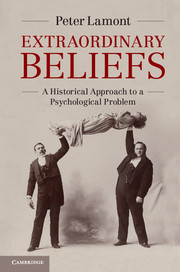Book contents
- Frontmatter
- Contents
- A brief reflexive preface
- Acknowledgements
- ONE Introduction
- TWO The making of the extraordinary
- THREE The making of mesmeric phenomena
- Four The making of spiritualist phenomena
- FIVE The making of psychic phenomena
- SIX The making of paranormal phenomena
- SEVEN The making of extraordinary beliefs
- Notes
- Bibliography
- Index
SIX - The making of paranormal phenomena
Published online by Cambridge University Press: 05 April 2013
- Frontmatter
- Contents
- A brief reflexive preface
- Acknowledgements
- ONE Introduction
- TWO The making of the extraordinary
- THREE The making of mesmeric phenomena
- Four The making of spiritualist phenomena
- FIVE The making of psychic phenomena
- SIX The making of paranormal phenomena
- SEVEN The making of extraordinary beliefs
- Notes
- Bibliography
- Index
Summary
In 1974, Uri Geller sat in a room with some very respectable scientists. It was part of a laboratory at Stanford Research Institute, and Geller's paranormal abilities were being tested by physicists. During most of the formal tests, he was isolated in an electrically shielded room, while somebody outside drew something on a piece of paper. Despite being unable to see the drawing, or even know who was drawing it, Geller managed to draw an almost exact duplicate.
The experiments, which included several trials like this, were reported in Nature, and the authors were quite clear that this was an attempt ‘to resolve…whether a certain class of paranormal phenomena exist’. Naturally, this required the exclusion of ordinary explanations, so ‘we conducted our experiments with sufficient control, utilizing visual acoustic and electrical shielding, to ensure that all conventional paths of sensory input were blocked’. Whether such measures were ‘sufficient’, of course, depended upon their competence to assess what was sufficient, but they explained that they had investigated the ability before, carried out pilot studies, and both their knowledge of the literature and their observations led them to conclude that ‘such abilities can be studied in laboratory conditions’. Such abilities were compatible with scientific investigation, amenable to ‘analysis and hypothesis in the forms with which we are familiar in scientific study’.
- Type
- Chapter
- Information
- Extraordinary BeliefsA Historical Approach to a Psychological Problem, pp. 198 - 241Publisher: Cambridge University PressPrint publication year: 2013



